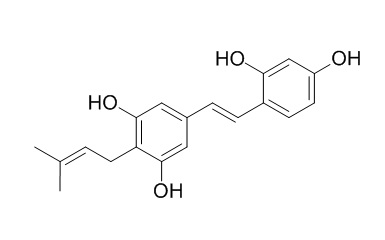4'-Prenyloxyresveratrol
4'-Prenyloxyresveratrol is a natural product from Morus wittiorum.
Inquire / Order:
manager@chemfaces.com
Technical Inquiries:
service@chemfaces.com
Tel:
+86-27-84237783
Fax:
+86-27-84254680
Address:
1 Building, No. 83, CheCheng Rd., Wuhan Economic and Technological Development Zone, Wuhan, Hubei 430056, PRC
Providing storage is as stated on the product vial and the vial is kept tightly sealed, the product can be stored for up to
24 months(2-8C).
Wherever possible, you should prepare and use solutions on the same day. However, if you need to make up stock solutions in advance, we recommend that you store the solution as aliquots in tightly sealed vials at -20C. Generally, these will be useable for up to two weeks. Before use, and prior to opening the vial we recommend that you allow your product to equilibrate to room temperature for at least 1 hour.
Need more advice on solubility, usage and handling? Please email to: service@chemfaces.com
The packaging of the product may have turned upside down during transportation, resulting in the natural compounds adhering to the neck or cap of the vial. take the vial out of its packaging and gently shake to let the compounds fall to the bottom of the vial. for liquid products, centrifuge at 200-500 RPM to gather the liquid at the bottom of the vial. try to avoid loss or contamination during handling.
J. Korean Wood Sci. Technol.2022, 50(5):338-352.
J Mass Spectrom.2022, 57(2):e4810.
Korean. J. Pestic. Sci.2024, 28(3):241-248.
J Ethnopharmacol.2020, 269:113752.
Plants.2024, 13(10):1348;
Biomed Chromatogr.2019, 8:e4774
Analytical Letters 2021, 54(4).
Pharm Biol.2022, 60(1):2040-2048.
Current Topics in Nutraceutical Research2021, 19(1),p90-105.
Univerzita Karlova2021, 20.500.11956.
Related and Featured Products
Zhongguo Zhong Yao Za Zhi. 2010 Oct;35(20):2700-3.
Phenolic constituents from stem bark of Morus wittiorum and their anti-inflammation and cytotoxicity.[Pubmed:
21246822]
To search for the chemical constituents possessing anti-inflammatory or cytotoxic activities from plants, Morus wittiorum was investigated for the first time.
METHODS AND RESULTS:
The stem bark of M. wittiorum was extracted with 95% EtOH. The EtOH extract was fractionationed on silica gel by eluting with petroleum ehter, CHCl3 and EtOAc successively. The further isolation and purification of the EtOAc fraction of 95% EtOH extract was performed by various column chromatography such as silica gel, Sephadex LH-20, RP-C18 column chromatography and so on. The structures of compounds were determined on the basis of spectral analysis such as NMR, MS etc. As a result, nine compounds were isolated including six flavonoids and three stilbenoids and elucidated as quercetin (1), 5, 7, 3', 4'-tetrahydroxy-3-methoxyflavone (2), norartocarpanone (3), dihydrokaempferol (4), euchrenone a7 (5), morachalcone A (6), resveratrol (7), oxyresveratrol (8), 4'-Prenyloxyresveratrol (9).
CONCLUSIONS:
Compounds 1-9 were isolated from this plant for the first time, among which compounds 1-8 were evaluated for their anti-inflammatory and cytotoxic activities, respectively. Wherein compounds 6 and 8 showed inhibition to the release of beta-glucuronidase from rat polymorphonuclear leukocyte (PMNs) induced by platelet activating factor (PAF) at a concentration of 10(-5) mol x L(-1). The inhibitory ratios were 76.8%, 94.2% individually. Compounds 2 and 8 exhibited selective cytotoxicity agaist human ovarian cancer (A2780) and human gastric cancer (BGC-823) with IC50 values as 0.66, 1.31 micromol x L(-1) individually.



